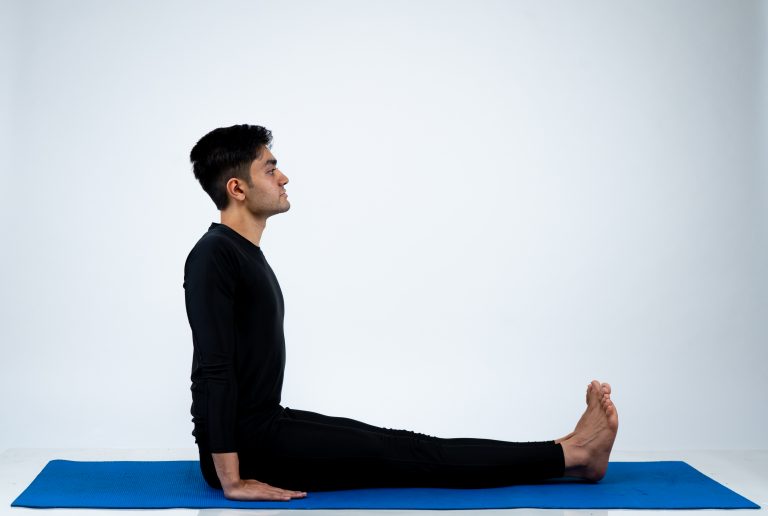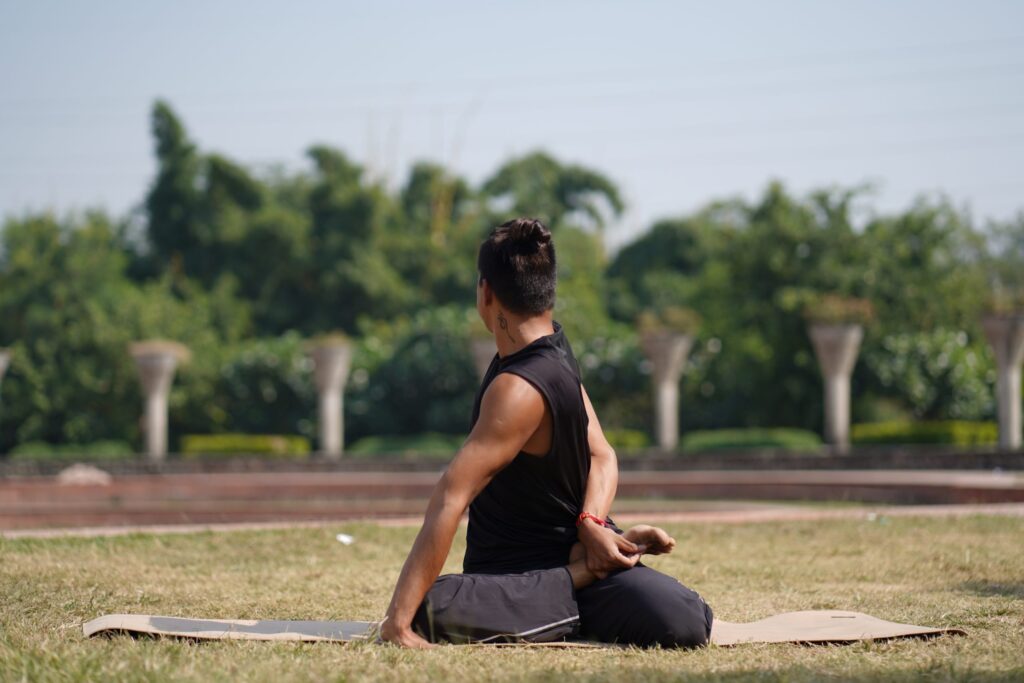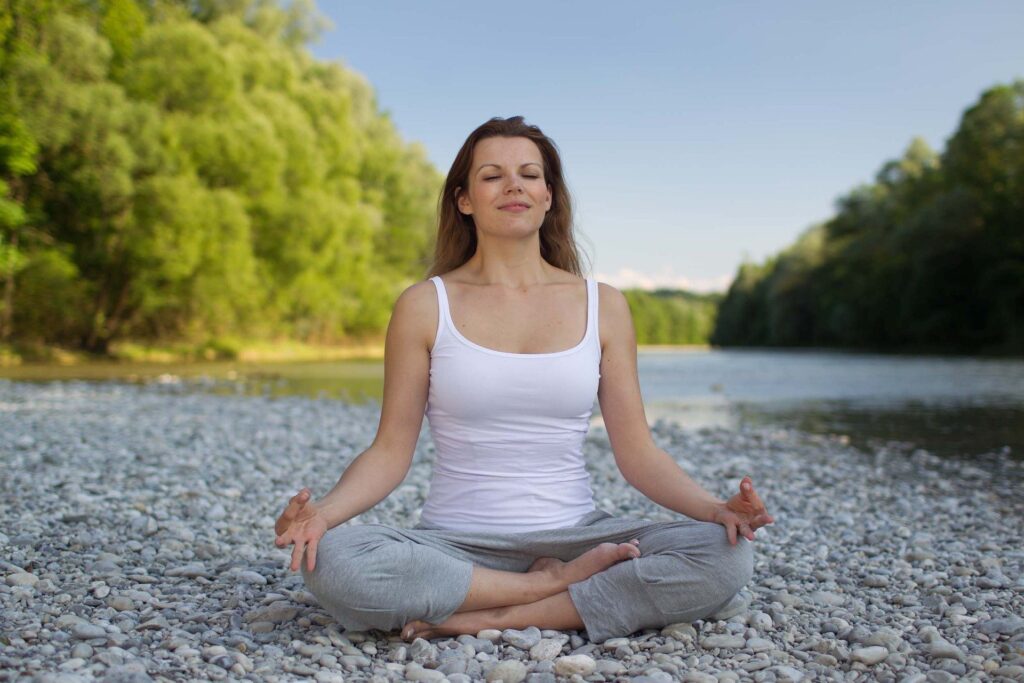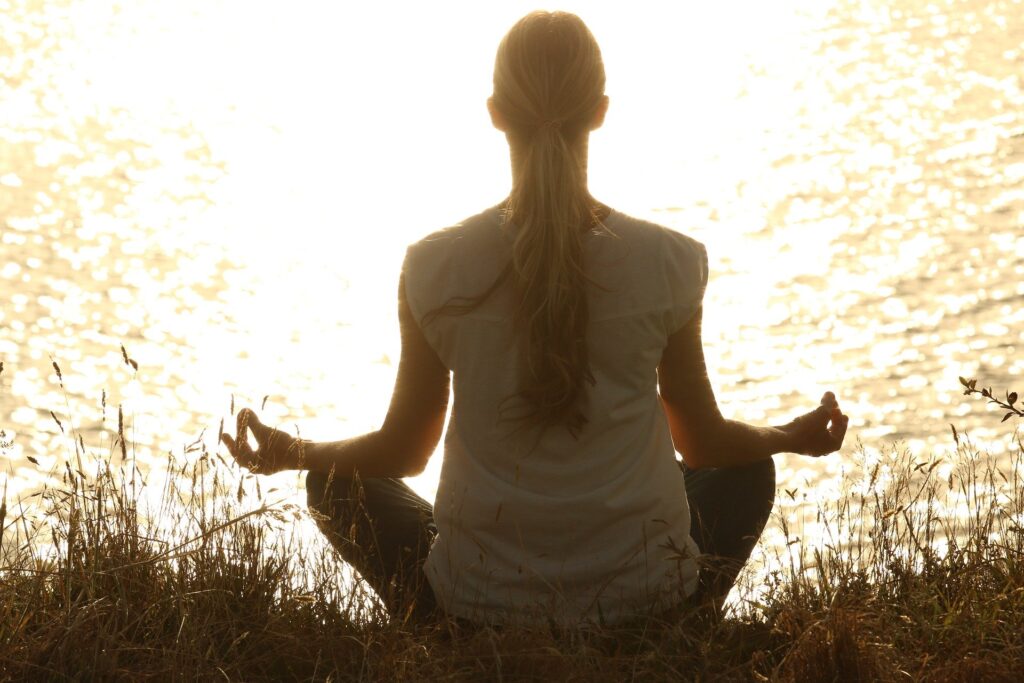Dandasana ( दण्डासन ) is also known by different names – ‘The Staff Pose’ or ‘The Base Pose’. This asana is the foundation for all seated poses that helps to overcome laziness and tiredness. In this article, we’ll talk about various such health benefits, steps and precautions for performing ‘Dandasana’.
A Sanskrit word ‘Dandasana’ is the combination of two words Danda ( दण्ड ) means ‘Staff‘ or ‘Stick‘ and Asana ( आसन ) means ‘Posture or seat’. In this asana, you’ve to sit on the floor with your back straight and legs extended in front of your torso. Here, your spine resembles a staff/rod in appearance.

The Staff Pose is a beginner level yoga asana that makes your spine, chest, abdomen, shoulders and back muscles stronger. Furthermore, it also prepares your body for more challenging and intense stretching yoga asanas.
Dandasana is a part of Ashtanga Vinyasa Yoga that is extensively mentioned in ancient Indian texts – Sritattvanidhi and Haṭha Ratnavali Vyayama. This pose connects Mula Bandha, Uddiyana Bandha & Jalandhara Bandha.
How to practice Dandasana – The Staff Pose
Following are the step – by – step instructions to follow for the practice of Dandasana ( The Staff Pose ) :
Step 1
- Sit on the ground with your back straight & legs extended in front of your torso.
Step 2
- Keep your hands on the ground outside your hips with fingers pointing forward.
Step 3
- Breathe in and keep the spine straight pressing sitting bones within the ground.
Step 4
- Firm the thighs and rotate them gently towards each other keeping feet flexed.
Step 5
- Draw chin towards the chest and drop shoulder blades down towards the back.
Step 6
- Now, look forward, broaden your collarbones & tighten up abdominal muscles.
Step 7
- Pull inner groins toward sacrum and flex ankles pressing out through the heels.
Step 8
- Breathe normally as you hold the pose & imagine your spine as the staff or rod.
Step 9
- Remain in this final position up to 30-60 seconds or as per your body’s comfort.
Step 10
- To come out from this pose, place your hands on the floor and relax your body.
Step 11
- Inhale deeply & exhale slowly as you release the pose and repeat it for 3 times.
Modifications and Variations
Chaturanga Dandasana, Viparita Dandasana and Supta Dandasana are some major variations of Dandasana or Staff pose.
To deepen experience during Dandasana, try out following modifications and find a suitable variation that works for you :
- If you cannot place hands flat on the floor, you can use blocks under your hands and push them down onto the blocks.
- If you’ve tight hamstrings then sit on a blanket to raise pelvis or bend knees slightly to lessens the strain of hamstrings.
- To straighten your back, you may practice this pose against the wall with your sacrum and shoulder blades touching it.
- If you are unable to sit up straight or have a rounded back then placing a folded blanket under butts would be helpful.
- If in case you hyperextend knees, then keep heels on the ground as this will prevent your knees from hyperextending.
Top 7 Health Benefits of Dandasana – Staff Pose
The powerful calming effects of this relaxing pose makes it easier to hold the body in seated meditation for longer.
Following are the 7 major Health Benefits of Dandasana – The Staff Pose that you may attain with regular practice :
1. Dandasana Helps to Improve Muscles Strength
- Dandasana strengthens your spine, shoulders, quads, hip flexors, lower back, abdominal and pelvic floor muscles.
- Apart from this, by performing the staff pose regularly aids in opening of the chest, calves, glutes and hamstrings.
Also Read :
2. Dandasana Helps to relieve Pain and Stiffness
- The regular practice of Dandasana helps to relieve stiffness and pain from your shoulders, hips and back muscles.
- Plus, it also alleviates sciatica pain & inflammations due to injuries or conditions such as arthritis, osteoporosis etc.
Also Read :
3. Dandasana Helps to improve your Body Posture
- Dandasana corrects irregular alignment of the body and cures postural deformities such as scoliosis and kyphosis.
- This asana is an effective exercise that revamps the hunched posture while standing, walking, sitting and sleeping.
Also Read :
4. Dandasana Helps to Restore Body’s Flexibility
- Yoga Dandasana helps to improve the flexibility that is vital for a full range of motions of the hips and pelvis region.
- It improves sturdy structure, makes backbone flexible, reduces neck stiffness & prevents shoulders from rounding.
Also Read :
5. Dandasana Stimulates Parasympathetic Nervous System
- By performing the Staff Pose helps to transform sympathetic nervous system to parasympathetic nervous system.
- Furthermore it also helps to maintain energy levels, decreases stress hormone cortisol and calms nervous system.
Also Read :
6. Dandasana Helps to improves Mental Health
- Daily practice of Dandasana offers soothing effects on brain cells that reduces stress, anxiety and mild depression.
- Plus, it helps to overcome emotional irritability, improves the concentration level and prepares meditative mindset.
Also Read :
7. Dandasana Helps to Improve your Digestion
- This asana improves the functionality of your digestive organs that prevents constipation, acid reflux, flatulence etc.
- Plus, this pose strongly engages the transverse abdominus in lower abdomen that build core strength and stability.
Also Read :
Precautions and Contraindications
- Avoid doing this asana, if you have tight glutes, short hamstrings, chronic spinal problems or hyperextend knees.
- Avoid practicing this pose if you have suffered an injury in your wrists, arms, shoulders, lower back, thighs or legs.
- If you are feeling severe sciatic nerve pain, be careful to not work so hard in this asana that you increase the pain.
- Avoid the performance of Dandasana or Staff Pose, if you are suffering from high blood pressure or hypertension.
- If you’re suffering from severe pain in the legs, arms, knee or back, let yourself heal first before you do this asana.
- Avoid practicing this pose if you have recently undergone through any surgery unless you’ve healed completely.
- You should avoid the practice of Dandasana, if you are experiencing severe fever, cold, flu, fatigue or exhaustion.
Preparatory Poses
- Katichakrasana
- Urdhva Hastasana
- Uttanasana
- Ardha Uttanasana
- Baddha Konasana
- Prasarita Padottanasana
- Gomukhasana
- Trikonasana
- Sukhasana
- Janu Sirsasana
Follow Up Poses
- Bharadvajasana
- Purvottanasana
- Paschimottanasana
- Adho Mukha Svanasana
- Setu Bandha Sarvangasana
- Akarna Dhanurasana
- Vasisthasana
- Tolangulasana,
Tips for Beginners
- Dandasana is a beginner level yoga asana so you can add this asana in your workout regimens at the end of a yoga session.
- You may practice Dandasana both in morning and evening with gap of 2-4 hours gap between your meal and your practice.
- If you’ve any pre-existing medical problems, consult a doctor & practice it under the supervision of a certified yoga teacher.
- Always practice this asana in a space that’s clean and clutter-free. Switch off your mobile phone & TV to avoid distractions.
Conclusion
Dandasana is a very simple yet powerful asana that offers tremendous benefits – treats shortness of breath, cures asthma, improve stamina, relieves fatigue, stimulates reproductive organs, overcoming vertigo and feeling of dizziness etc.
We really hope that this article would be useful guide for your practice of Dandasana aka Staff Pose. Try out this wonderful asana after a long tiring day and do share your thoughts and suggestions on this article in the comment section below.
Also Read :
FAQs Related To Dandasana and its Health Benefits
How can practice of Dandasana help to overcome poor body posture ?
Dandasana helps to stretch and lengthen spine, hamstrings, calves, legs, ankles, heels, inner thighs, shoulders, quadriceps, lower limbs, chest, abdomen and back muscles. This incredible pose improves spinal awareness & corrects the postural problems due to prolonged sitting or sedentary lifestyle.
How do Dandasana or the Staff Pose help to improve mental health ?
Dandasana helps to improve flow of prana energy in the upward direction and it’s flow through the chakras of the subtle body. It keeps you grounded by building balance and inducing feelings of humility and connectedness. Moreover, it also reduces obesity, heart problems, high blood pressure etc.
Who can perform Dandasana or the staff pose safely ?
Dandasana is a beginner level seated yoga pose that can be easily performed by people of all age groups. For example this pose can be seniors, children above 5 years and Pregnant women. It is the best warm-up pose that reduces risk of repetitive strains, cures injuries and provides relief instantly.



